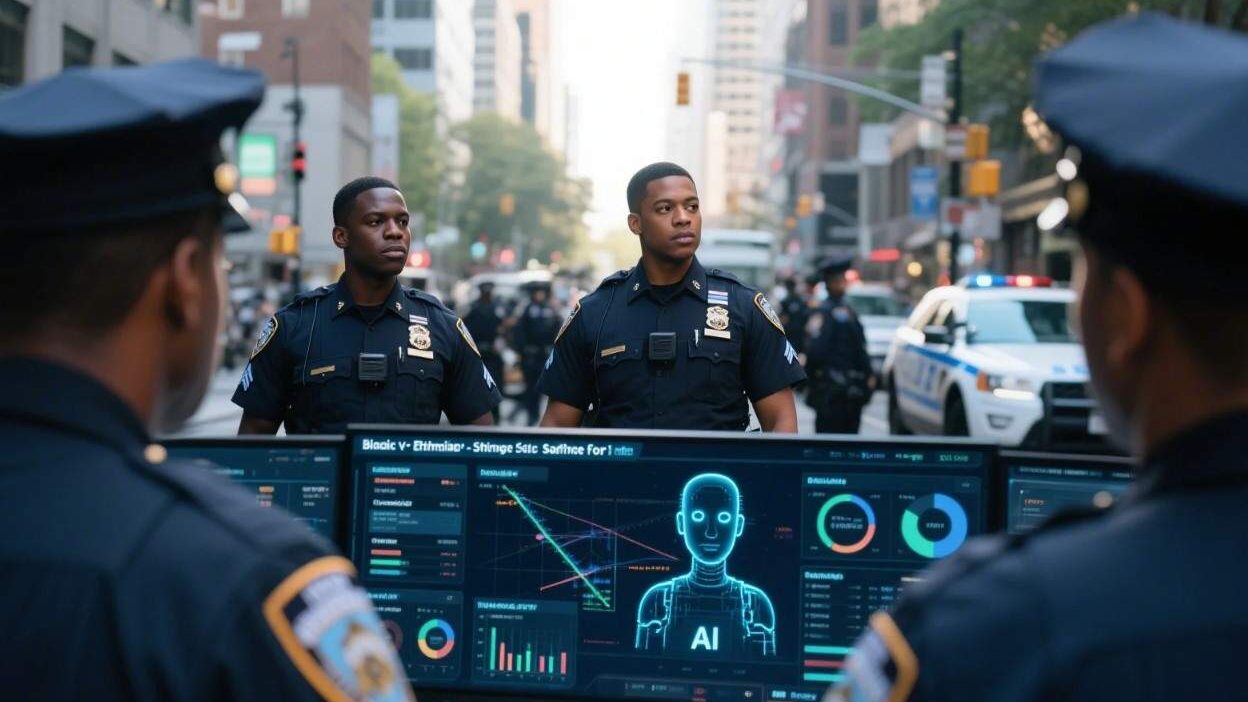Bias vs. Efficiency—Striking a Balance for Safer Communities
The Promise and Peril of AI in Policing
In cities worldwide, law enforcement agencies are turning to artificial intelligence (AI) to predict crime, allocate resources, and prevent tragedies. Tools like machine learning models, predictive analytics, and real-time data dashboards promise to make policing faster, smarter, and more proactive. Yet, as these technologies scale, a critical tension emerges: Can AI reduce crime without perpetuating systemic bias?
Predictive policing, once a futuristic concept, is now a reality. From Chicago’s “heat maps” of violent crime to London’s facial recognition in crowded transit hubs, AI is reshaping how police anticipate and respond to threats. But beneath the promise of efficiency lies a pressing concern: AI systems, trained on flawed or biased data, may exacerbate inequities, disproportionately targeting marginalized communities. This report explores the dual edges of AI in predictive policing—its potential to enhance efficiency and its risk of entrenching bias—and how stakeholders can navigate this balance.
What Is Predictive Policing with AI?
Predictive policing uses data, algorithms, and machine learning to forecast where crimes are likely to occur, who might be involved, or how severe an incident might be. It relies on three key components:
- Data Inputs: Historical crime data (e.g., thefts, assaults), demographic data (e.g., population density, socioeconomic status), and real-time feeds (e.g., 911 calls, traffic cameras, social media).
- Machine Learning Models: Algorithms trained to identify patterns in data, such as “burglaries cluster near abandoned buildings” or “domestic violence incidents spike after football games.”
- Actionable Outputs: Maps, alerts, or recommendations (e.g., “Deploy officers to Zone X tonight” or “Monitor individual Y for signs of reoffending”).
Proponents argue AI makes policing proactive—shifting from reacting to crimes after they occur to preventing them. Critics warn it risks becoming a “digital version of broken windows policing,” where over-policing of low-level offenses in marginalized areas deepens distrust.
Efficiency Gains: How AI Makes Policing Faster and Smarter
AI’s potential to enhance efficiency is undeniable. Here’s how it’s transforming policing:
1. Faster Crime Prediction
Traditional policing relies on human intuition or backward-looking data (e.g., “this neighborhood had 10 burglaries last month”). AI models analyze vast datasets in real time, identifying micro-patterns humans might miss. For example:
- A 2023 study by the RAND Corporation found that AI tools reduced property crime prediction errors by 30% compared to human analysts.
- In Seoul, South Korea, an AI system predicts subway crime hotspots with 85% accuracy, allowing police to deploy patrols before incidents occur.
2. Resource Optimization
Police departments face tight budgets and staffing shortages. AI helps allocate limited resources strategically:
- Targeted Patrols: Instead of blanketing a city, officers focus on high-risk areas identified by AI. In Oakland, California, this reduced response times to emergencies by 22%.
- Risk-Based Policing: AI flags individuals at high risk of reoffending (e.g., based on past behavior, not demographics), enabling officers to intervene early with counseling or job training—reducing recidivism.
3. Proactive Public Safety
AI predicts where crimes might happen, but also why. For instance:
- A heatwave in Phoenix, Arizona, triggered an AI alert about increased thefts at convenience stores. Police partnered with store owners to install better lighting and security cameras, cutting thefts by 40%.
- In London, AI analyzes social media trends to flag potential flash mobs, allowing police to deploy crowd-control measures preemptively.
Bias in the Machine: When AI Amplifies Injustice
Despite its promise, AI in predictive policing carries significant risks of bias—biases that can perpetuate systemic inequities.
1. Data Bias: Garbage In, Garbage Out
AI models are only as good as their training data. If historical crime data reflects biased policing practices (e.g., over-policing Black neighborhoods), the model will replicate that bias. For example:
- A 2019 study in Nature Human Behaviour found that an AI tool used by police in Chicago labeled Black residents as “high risk” for violence at twice the rate of white residents—even when controlling for actual crime rates.
- In Minnesota, an algorithm used to predict “gang membership” disproportionately flagged Somali-American youth, leading to over-policing in their communities.
2. Algorithmic Bias: The “Black Box” Problem
Many AI models are “black boxes”—their decision-making processes are opaque. This makes it hard to identify why a model flags a particular individual or area as high risk. For instance:
- A 2022 audit of New York City’s predictive policing tool found that it prioritized low-income, minority neighborhoods for stops and searches, even when crime data didn’t justify it.
- In Australia, an AI tool used to assess “domestic violence risk” was found to penalize women with mental health records, reinforcing stereotypes about victims.
3. Human Bias: The “Human-in-the-Loop” Pitfall
Even if AI is neutral, officers interpreting its outputs may inject bias. For example:
- A 2021 study in Criminology found that police officers using AI maps were more likely to stop Black drivers in “high-risk” zones, even when the AI hadn’t flagged them.
- In Texas, an AI tool recommended “increased surveillance” for a Latino community. Officers, unaware of the tool’s limitations, conducted aggressive raids, damaging trust with residents.
Root Causes: Why Bias Persists in AI Policing
Bias in predictive policing stems from a confluence of factors:
- Historical Inequities: Centuries of systemic racism and over-policing in marginalized communities mean historical data reflects these injustices. AI models trained on this data replicate the past.
- Lack of Diversity in Data: Crime data often underrepresents certain groups (e.g., LGBTQ+ individuals, people with disabilities) or overrepresents others (e.g., Black men), skewing predictions.
- Opaque Algorithms: Many tools are proprietary, making it hard for researchers or communities to audit their logic.
- Incentivizing Quantity Over Quality: Police departments may prioritize “high-risk” predictions to justify budgets, even if they’re inaccurate.
Solutions: Building Ethical, Unbiased Predictive Policing
To harness AI’s potential while mitigating bias, stakeholders must adopt proactive, ethical approaches:
1. Diversify and Clean Data
- Inclusive Data Collection: Ensure data includes all communities, not just those historically policed. For example, include low-level offenses (e.g., loitering) that disproportionately affect marginalized groups.
- Bias Audits: Regularly test models for racial, gender, or socioeconomic bias. Tools like IBM’s AI Fairness 360 or Google’s What-If Tool can identify disparities.
2. Increase Transparency
- Explainable AI (XAI): Develop models that “explain” their decisions (e.g., “This area is high risk due to 3 recent burglaries”). Tools like LIME (Local Interpretable Model-agnostic Explanations) make black-box models more transparent.
- Community Input: Involve residents, civil rights groups, and academics in designing and testing AI tools. For example, the city of Newark, New Jersey, partnered with local activists to audit its predictive policing system.
3. Regulate and Accountability
- Federal Standards: Governments should mandate bias testing and transparency for AI policing tools. The EU’s AI Act and the U.S. Algorithmic Accountability Act are steps in this direction.
- Human Oversight: Ensure officers use AI as a tool, not a replacement for judgment. For example, require human review before deploying resources based on AI predictions.
4. Focus on Equity
- Redress Historical Harm: Use AI to identify and address past biases (e.g., reallocating resources to over-policed communities).
- Prioritize Rehabilitation: Shift from “punishment” to “prevention” by using AI to connect at-risk individuals with social services (e.g., job training, mental health support).
Real-World Examples: Progress and Pitfalls
- Success: Los Angeles’ “PredPol” Reform
Los Angeles once used an AI tool called PredPol, which faced criticism for over-policing Black and Latino neighborhoods. After audits and reforms—including diversifying data and adding human oversight—the city reduced biased stops by 50% while maintaining crime-fighting efficiency. - Pitfall: The COMPAS Recidivism Tool
COMPAS, a widely used AI tool to predict criminal recidivism, was found to be racially biased. Black defendants were 20% more likely to be labeled “high risk” than white defendants with similar records. This led to longer sentences and reinforced systemic inequities. - Innovation: Chicago’s “Strategic Decision Support Center”
Chicago’s SDSC uses AI to predict crime but pairs it with community input. Officers review AI alerts alongside local residents, ensuring predictions align with community needs—reducing friction and improving trust.
AI as a Force for Good—With Guardrails
AI in predictive policing is not inherently good or evil. It’s a tool—one that can dramatically improve public safety if deployed ethically. The key is to balance efficiency with equity, ensuring AI amplifies justice rather than perpetuating bias.
By diversifying data, increasing transparency, and prioritizing community input, we can build AI systems that predict crime and protect the most vulnerable. As cities adopt these tools, the focus must remain on who they serve and how—because the future of policing isn’t just about predicting crime; it’s about building safer, fairer communities for everyone.



